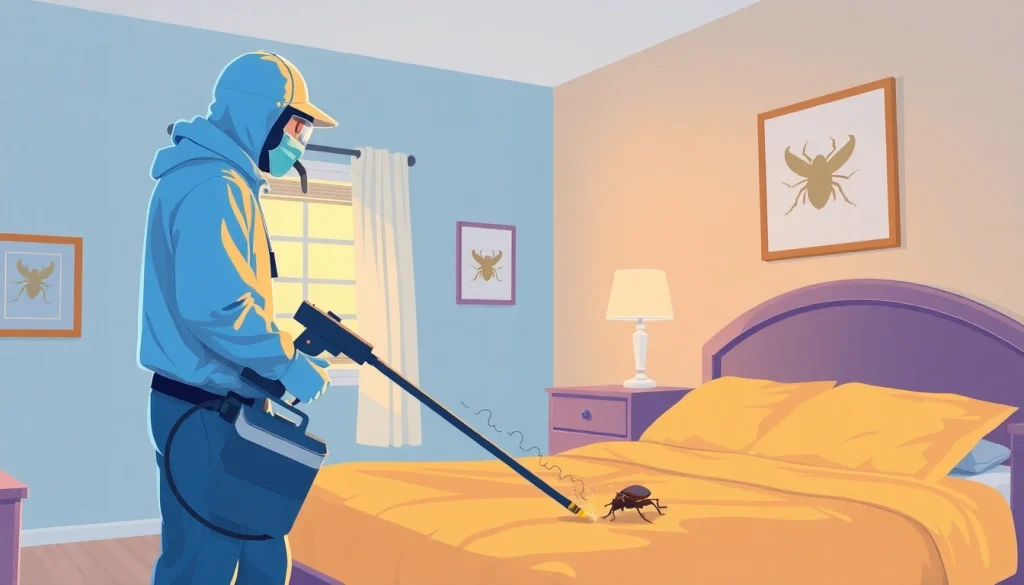Understanding Bed Bug Infestations
Bed bugs are small, parasitic insects that feed on the blood of humans and animals. Their resurgence in recent years has made them a significant nuisance and health concern in many households. Understanding bed bug infestations is crucial for effective bed bug pest control. This section delves into how to recognize these pests, the places they commonly inhabit, and their effects on health and wellbeing.
Identifying Bed Bugs: Signs to Look For
Identifying bed bugs early can prevent a small invasion from evolving into a full-blown infestation. Some common signs to look out for include:
- Physical Appearance: Adult bed bugs are reddish-brown, approximately the size of an apple seed (about 5-7 mm in length). Nymphs are smaller and lighter in color.
- Exoskeletons: As bed bugs mature, they molt. The shed skins can often be found where they hide.
- Fecal Stains: Small, dark spots resembling pepper or ink stains on bedding or furniture are indicative of bed bugs feeding and excreting waste.
- Itchy Bites: Bed bug bites usually appear in clusters or lines on the skin and can lead to itching and discomfort.
- Sweet Musty Odor: A strong, unpleasant smell from bed bugs’ scent glands may indicate a heavy infestation.
Common Hiding Spots and Behaviors
Bed bugs are expert hiders, often found in places where humans spend the most time. Some typical hiding spots include:
- Mattresses and box springs
- Bed frames and headboards
- Cracks and crevices in walls and furniture
- Behind baseboards and outlets
- In luggage and clothing when traveling
Understanding their behavior, such as their nocturnal feeding habits, can assist in detecting them early and implementing control measures.
Impact of Bed Bugs on Health and Wellbeing
While bed bugs are not known to transmit diseases, their presence can cause various health issues, including:
- Allergic Reactions: Some individuals may develop more severe reactions, including skin rashes and blisters.
- Sleep Disruption: The anxiety and discomfort caused by bed bug bites can lead to insomnia and resultant fatigue.
- Emotional Distress: Infestations can contribute to feelings of embarrassment, anxiety, and depression.
Addressing a bed bug problem promptly is essential not only for physical health but also for mental health and overall wellbeing.
Effective Bed Bug Pest Control Methods
Once bed bugs are identified, effective control methods need to be implemented. Various approaches can be taken, ranging from professional services to do-it-yourself methods. Each comes with its own sets of advantages and challenges.
Professional Extermination Services
Professional pest control services often provide the most effective treatment for bed bug infestations. Here’s what to expect:
- Initial Inspection: Professionals will conduct a thorough inspection to map out the extent of the infestation.
- Treatment Options: Multiple treatment methods may be employed, including chemical insecticides, heat treatments, or a combination of both.
- Follow-Up Visits: Follow-up treatments are usually scheduled to ensure complete eradication, as adult bugs and eggs may remain after the initial treatment.
- Expert Guidance: Pest control experts offer guidance on preventive measures to avoid future infestations.
The cost of these services can vary widely based on the infestation severity and the size of the property, but many consider it a worthwhile investment for long-term relief.
DIY Approaches: When and How to Use Them
For those looking to address bed bugs independently, the following DIY methods can help:
- Heat Treatment: Bed bugs can be killed by high temperatures. Washing and drying bedding and clothing on high heat can effectively eliminate bugs and their eggs.
- Vacuuming: Regularly vacuuming mattresses, carpets, and furniture helps remove bugs and eggs.
- Use of Diatomaceous Earth: This powder can be sprinkled in areas where bed bugs hide, as it dehydrates and kills them on contact.
- Homemade Sprays: Alcohol or essential oil sprays may help repel or kill some bed bugs, although these are typically less effective than professional treatments.
While DIY methods can be effective for smaller infestations, severe cases may require professional help to ensure complete eradication.
Integrated Pest Management Techniques
Integrated Pest Management (IPM) is a comprehensive approach that combines various strategies for effective long-term control. This method not only focuses on immediate solutions but also on prevention strategies. Key components include:
- Inspection and Monitoring: Regular monitoring and inspections to identify problems early.
- Preventative Measures: Utilizing protective covers on mattresses and box springs, sealing cracks and crevices, and being cautious when traveling can prevent new infestations.
- Combination Treatments: Utilizing both chemical and non-chemical treatments can tackle different life stages of bed bugs.
By implementing IPM strategies, homeowners can cultivate an environment that reduces the likelihood of bed bugs returning.
Costs and Factors Affecting Bed Bug Treatments
Understanding the costs associated with bed bug treatments is vital for budgeting and financial planning. The total expense can be influenced by several factors.
Analyzing Treatment Options and Pricing
The costs of bed bug treatment can vary significantly based on factors such as:
- Infestation Severity: Heavily infested areas will require more rigorous (and often costly) treatments.
- Property Size: Larger properties typically incur higher costs due to the increased treatment area.
- Type of Pest Control Service: Professional extermination services will generally be more expensive than DIY methods but are often more effective.
On average, professional extermination can range from $300 to $1,500, depending on these variables.
Insurance and Financial Assistance
While not all homeowners’ insurance policies cover bed bug extermination, it’s essential to check your policy for potential coverage options. Some non-profit organizations and community services may also offer assistance programs designed to help families in need of pest control. Understanding these options can alleviate the financial burden associated with extermination.
Long-Term Prevention Strategies
Investing time and effort into preventive measures can significantly reduce the chances of a bed bug resurgence. Here are some strategies to consider:
- Regular Inspections: Conduct regular inspections of bedding and furniture.
- Travel Precautions: Inspect hotel rooms and luggage before bringing items home, and keep luggage elevated off the ground while traveling.
- Education: Stay informed on the latest bed bug control methods and community resources.
By actively engaging in preventive practices, homeowners can maintain a bed bug-free environment.
Safety During Bed Bug Extermination
Safety is a vital concern during bed bug pest control. It is imperative to understand the various risks associated with treatments and the precautions necessary to in ensuring safety both during and after pest control measures.
Health Considerations for Treatments
Chemical treatments can pose potential health risks to humans and pets. Users should be aware of:
- Allergic Reactions: Some individuals may be sensitive or allergic to pesticide chemicals.
- Respiratory Issues: Prolonged exposure to chemicals can cause respiratory issues.
- Pre-existing Conditions: Those with asthma or allergies should take extra precautions during treatments.
Always follow label instructions and consider opting for less toxic treatments where applicable.
Protecting Your Belongings and Home
Protecting your belongings during bed bug treatment is critical. Here are steps to prepare your home:
- Remove clothing and personal items from infested areas and clean them thoroughly.
- Cover or move furniture as directed by the pest control professional.
- Seal any off-site items in plastic bags until they can be treated.
Proper preparation can help ensure that belongings are not unnecessarily damaged or contaminated during the extermination process.
Safe Use of Chemicals and Tools
When applying chemical treatments or using pest control tools, safety should be your priority. Essential tips include:
- Always read and follow the safety instructions on product labels.
- Wear protective gear to minimize exposure to chemicals.
- Ensure that the area being treated is well-ventilated.
Taking precautions can reduce health risks while increasing the effectiveness of treatment.
Staying Informed and Prepared
Knowledge is power, especially when it comes to managing bed bug infestations effectively. Staying informed about bed bug issues can aid in prevention and control.
Resources for Ongoing Bed Bug Education
Utilize available resources to expand your knowledge about bed bugs and their control. Helpful resources can include:
- The U.S. Environmental Protection Agency website for guidance on prevention and treatment.
- Local health departments for community resources and information.
- Books and online courses dedicated to pest management.
Continuing education can empower homeowners to take proactive approaches to bed bug management.
Emergency Plans for Infestations
Having a clear plan of action for dealing with a bed bug infestation can minimize panic during an emergency. An effective emergency strategy should include:
- A list of pest control services to contact immediately.
- Knowledge of how to inspect your home for bed bugs quickly.
- Preparedness for potential lodging needs if severe infestation disrupts home life.
Planning ahead can ensure that individuals and families respond effectively and timely.
Community Support and Local Services
Connecting with local resources and support communities can be instrumental in addressing bed bug challenges. Look for:
- Local pest control agencies offering expertise and community outreach programs.
- Online forums where individuals share experiences and advice.
- Community support groups for emotional support and shared knowledge.
Establishing connections within your community can offer additional resources and social support during tough times.


